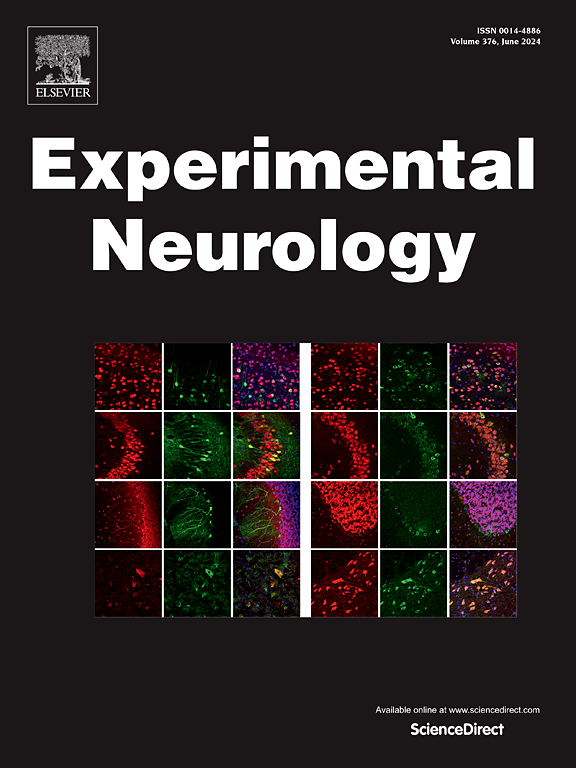Extract from Nasco pomace loaded in nutriosomes exerts anti-inflammatory effects in the MPTP mouse model of Parkinson's disease
IF 4.6
2区 医学
Q1 NEUROSCIENCES
引用次数: 0
Abstract
Neuroinflammation has recently emerged as a key event in Parkinson's disease (PD) pathophysiology and as a potential target for disease-modifying therapies. Plant-derived extracts, rich in bioactive phytochemicals with antioxidant properties, have shown potential in this regard. Yet their clinical utility is hampered by poor systemic availability and rapid metabolism. Recently, our group demonstrated that intragastric delivery of Nasco pomace extract via nutriosomes (NN), a novel nanoliposome formulation, contrasts the degeneration of nigrostriatal dopaminergic neurons in a subacute 1-methyl-4-phenyl-1,2,3,6-tetrahydropyridine (MPTP) mouse model of PD. In the present study, we investigated the impact of intragastric NN treatment on the reactivity of glial cells in the substantia nigra pars compacta (SNc) and caudate-putamen (CPu) of MPTP-treated mice. To this scope, in mice exposed to MPTP (20 mg/kg/day, × 4 days), we conducted immunohistochemistry analyses of glial fibrillary acidic protein (GFAP) and ionized calcium-binding adapter molecule 1 (IBA1) to assess the responsiveness of astrocytes and microglial cells, respectively. Additionally, we studied the co-localization of the pro-inflammatory interleukin (IL)-1β and tumor necrosis factor (TNF)-α with IBA1 to obtain insights into microglial phenotype. Immunohistochemical results showed that NN administration significantly mitigated astrogliosis and microgliosis in the CPu and SNc of mice receiving subacute MPTP treatment, with region-specific variations in anti-inflammatory efficacy. Remarkably, the CPu showed a heightened response to NN treatment, including a pronounced decrease in microglial IL-1β and TNF-α production. Altogether, these findings underscore the anti-inflammatory effects of NN treatment and provide a potential mechanism underlying the neuroprotective effects previously observed in a subacute MPTP mouse model of PD.
在帕金森病 MPTP 小鼠模型中,营养体中含有的纳斯科果渣提取物具有抗炎作用。
最近,神经炎症已成为帕金森病(PD)病理生理学中的一个关键事件,并成为改变疾病疗法的一个潜在靶点。植物提取物富含具有抗氧化特性的生物活性植物化学物质,在这方面已显示出潜力。然而,这些提取物在临床上的应用却受到了全身可用性差和新陈代谢快的阻碍。最近,我们的研究小组证实,通过一种新型纳米脂质体制剂--营养体(NN)--胃内输送纳斯科果渣提取物,可在亚急性 1-甲基-4-苯基-1,2,3,6-四氢吡啶(MPTP)脑损伤小鼠模型中逆转黑质多巴胺能神经元的退化。在本研究中,我们探讨了胃内 NN 治疗对 MPTP 治疗小鼠黑质(SNc)和尾状核(CPu)神经胶质细胞反应性的影响。为此,我们对暴露于 MPTP(20 毫克/千克/天,×4 天)的小鼠进行了神经胶质纤维酸性蛋白(GFAP)和电离钙结合适配器分子 1(IBA1)的免疫组化分析,以分别评估星形胶质细胞和微胶质细胞的反应性。此外,我们还研究了促炎性白细胞介素(IL)-1β和肿瘤坏死因子(TNF)-α与IBA1的共定位,以深入了解小胶质细胞的表型。免疫组化结果表明,给予 NN 能显著缓解亚急性 MPTP 治疗小鼠 CPu 和 SNc 中的星形胶质细胞和小胶质细胞病变,抗炎效果因区域而异。值得注意的是,CPu 对 NN 治疗的反应更加强烈,包括小胶质细胞 IL-1β 和 TNF-α 的产生明显减少。总之,这些发现强调了 NN 治疗的抗炎作用,并为之前在亚急性 MPTP PD 小鼠模型中观察到的神经保护作用提供了潜在机制。
本文章由计算机程序翻译,如有差异,请以英文原文为准。
求助全文
约1分钟内获得全文
求助全文
来源期刊

Experimental Neurology
医学-神经科学
CiteScore
10.10
自引率
3.80%
发文量
258
审稿时长
42 days
期刊介绍:
Experimental Neurology, a Journal of Neuroscience Research, publishes original research in neuroscience with a particular emphasis on novel findings in neural development, regeneration, plasticity and transplantation. The journal has focused on research concerning basic mechanisms underlying neurological disorders.
 求助内容:
求助内容: 应助结果提醒方式:
应助结果提醒方式:


